January to December, 2022
Introduction
About the Ontario Employment Report – January to December, 2022
The Ontario Employment Report is released four times a year and provides an assessment of the current trends and developments in the Ontario labour market. The Ontario Employment Report is a companion report to the Ontario Economic Accounts, which provides an overall assessment of the current state of the Ontario economy.
The report for the fourth quarter of 2022 provides an assessment of Ontario’s labour market for the entire year, comparing annual averages, while the approach used in other quarterly reports is to measure year-over-year changes in quarterly data.
Methodological note
In the current issue, year-over-year change represents change between 2021 and 2022. Longer-term trends are included for select labour market characteristics and provide historical context.
All estimates in the report are based on Statistics Canada’s Labour Force Survey (LFS), which measures the current state of the national, provincial and territorial labour market. The LFS is based on a household survey carried out monthly by Statistics Canada in reference weeks of the month. All estimates in this report include the population aged 15 years and over, unless otherwise indicated.
This report incorporates revisions to the Labour Force Survey data on January 30, 2023, including transition to the 2021 National Occupational Classification. Estimates in this report may differ from estimates in previous reports due to these data revisions.
Overview
Key labour market indicators, 2022
Employment:
- +338,300 net jobs in 2022, year-over-year
- +283,500 net full-time jobs in 2022, year-over-year
Unemployment rate:
- 5.6% in 2022
Participation rate:
- 65.4% in 2022
Employment change by province, 2022
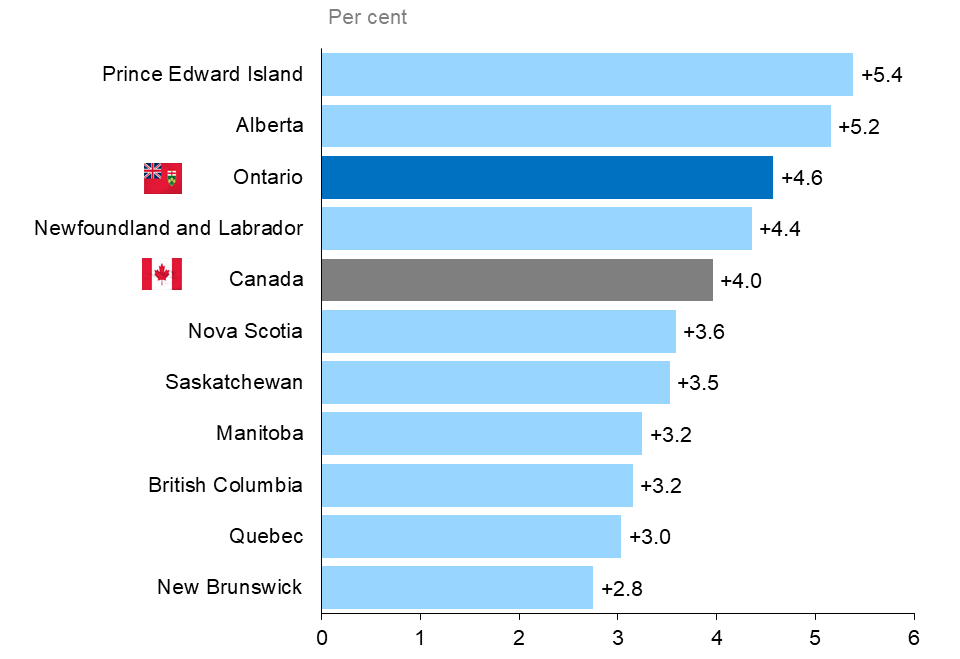
The horizontal bar chart shows the per cent annual employment change for the ten Canadian provinces and Canada. In relative terms, employment increased the most in Prince Edward Island (+5.4%), Alberta (+5.2%) and Ontario (+4.6%) and the least in New Brunswick (+2.8%). Canada’s employment increased by 4.0%
In 2022, Ontario’s employment increased by 4.6% (+338,300), following the largest annual increase on record
Ontario’s labour market, 1976-2022
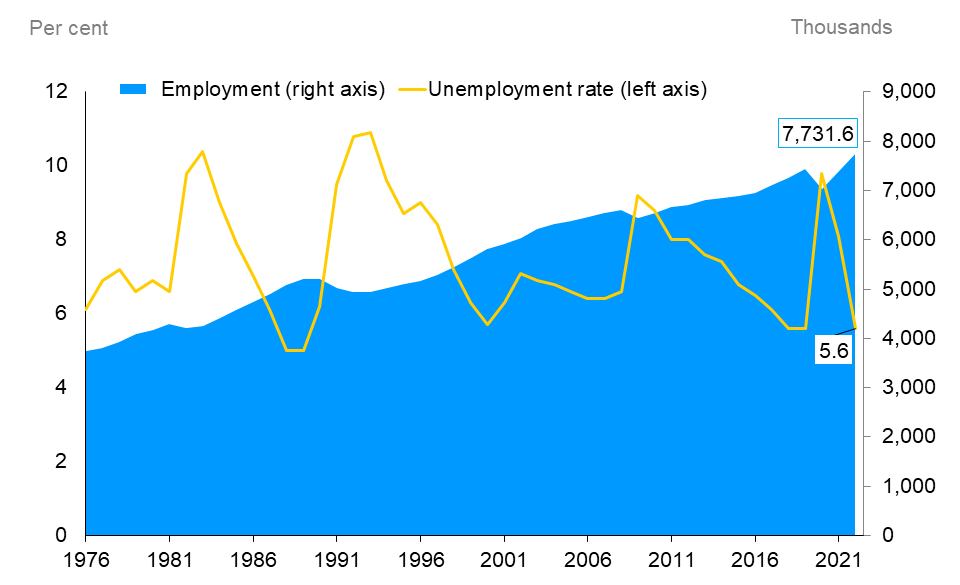
The combination line and area chart show Ontario’s unemployment rate (line chart) and employment (area chart) from 1976 to 2022. Ontario’s unemployment rate has fluctuated reaching highs of 10.4% in 1983, 10.9% in 1993, 9.2% in 2009 and 9.8% in 2020 and lows of 5.0% in 1988 and 1989, 5.7% in 2000 and 5.6% in 2018, 2019 and 2022. Employment in Ontario has risen steadily since 1976 with a few exceptions when employment contracted during recessions. The decrease in employment from 2019 to 2020 was sharper compared to previous recessions, but employment in 2022 is well above the 2019 level and the highest on record at 7,731,600.
In 2022, the unemployment rate in Ontario was 5.6%, above the Canadian rate (5.3%) and the fifth lowest rate among provinces. In 2022, the annual decrease in the unemployment rate (-2.5 percentage points) was the largest on record after the second largest decline in 2021 (-1.7 percentage points).
In 2022, the labour force participation rate in Ontario edged up by 0.2 percentage point to 65.4%, which was the same as the Canadian rate.
Highlights in 2022
- Employment increased among both part-time and full-time workers.
- The private sector and public sector experienced employment growth, while self-employment remained relatively unchanged.
- Employment increased in both the services-producing and goods-producing industries with the largest increase in professional, scientific and technical services, as well as construction.
- Among broad occupational groups, management occupations and sales and service occupations saw the largest increases in employment.
- Employment increased in all the five regions, with Central Ontario recording the highest percentage increase in employment.
- Employment levels increased relatively more for those with less than high school education, those with a postsecondary certificate or diploma, very recent immigrants aged 25 to 54 years, and youth, compared to their counterparts.
- Weekly hours worked stayed relatively unchanged for both full- and part-time workers and the total weekly hours worked were at their highest level compared to previous years.
- The average hourly wage of employees was $32.94, a decrease of 2.4% after accounting for inflation.
Type of work
Employment change by full-time, part-time status, 2022
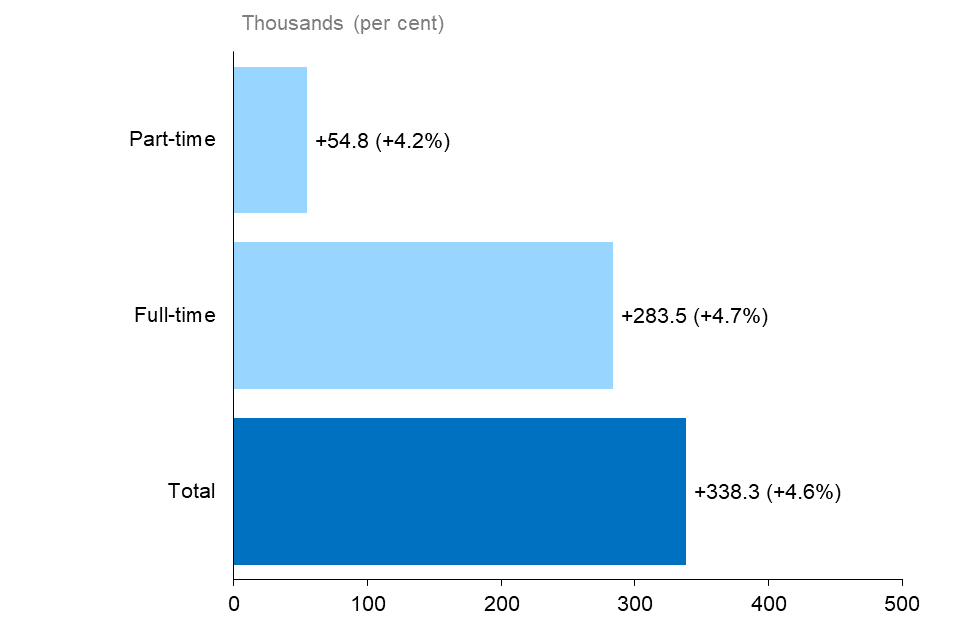
The horizontal bar chart shows Ontario’s annual employment change by full-time and part-time status, measured in thousands of jobs with percentage changes in brackets. Total employment increased by 338,300 (+4.6%), with full-time employment increasing by 283,500 (+4.7%), and part-time employment increasing by 54,800 (+4.2%).
In 2022, employment in Ontario increased by 4.6%, driven by increases in both full-time (+283,500, +4.7%) and part-time positions (+54,800, +4.2%).
Part-time employees experienced disproportionate job losses during the COVID-19 pandemic. In 2022, part-time employment was still 2.0% below its 2019 level, while full-time employment was 5.5% above its 2019 level.
Employment change by employment sector, 2022
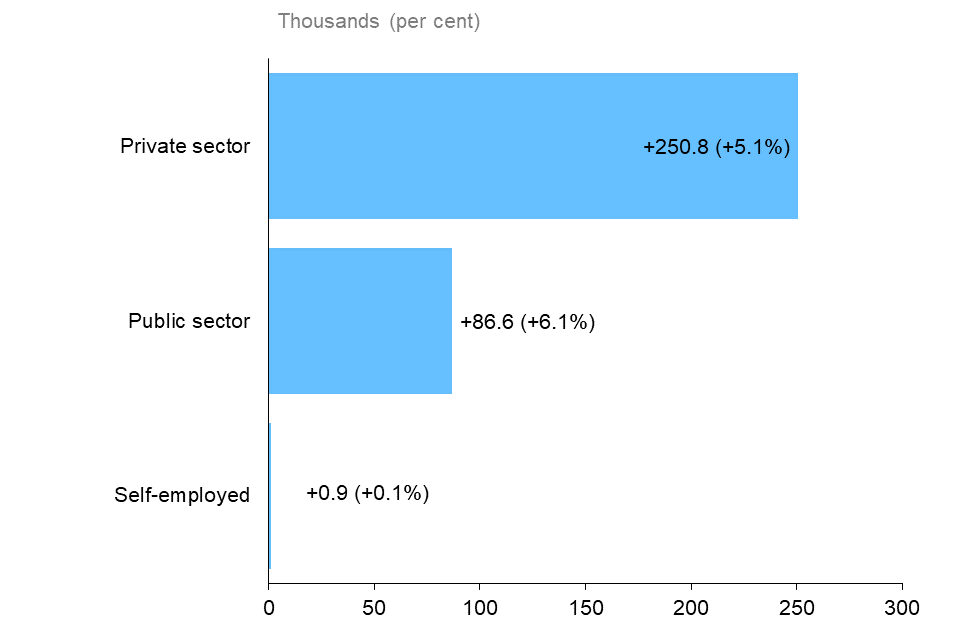
The horizontal bar chart shows Ontario’s annual employment change for the private sector, public sector and the self-employed, measured in thousands of jobs with percentage changes in brackets. Employment increased in the private sector (+250,800, +5.1%) and the public sector (+86,600, +6.1%) and edged up for the self-employed (+900, +0.1%).
The private sector had the largest increase in employment (+250,800, +5.1%), followed by the public sector
In 2022, self-employment was still below its 2019 pre-pandemic level (-60,500, -5.3%), while both private sector and public sector employment exceeded their 2019 levels.
Industry and occupation
In 2022, employment increased in both goods-producing (+77,300, +5.3%) and services-producing (+261,000, +4.4%) industries.
Employment change by industry, goods-producing industries, 2022
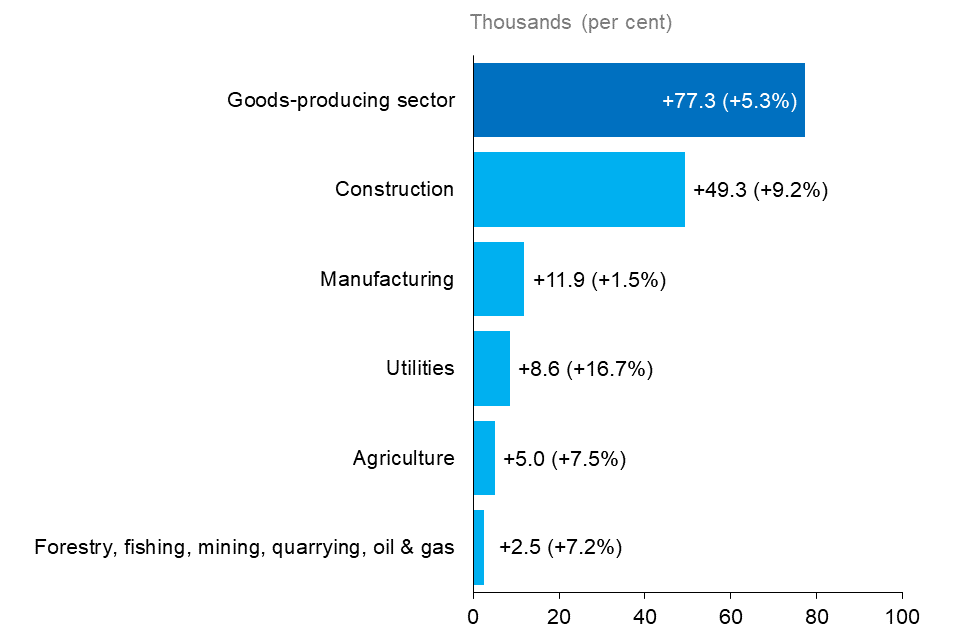
The horizontal bar chart shows Ontario’s annual employment change by industry for goods-producing industries, measured in thousands of jobs with percentage changes in brackets. Employment in most goods-producing industries increased: construction (+49,300, +9.2%), manufacturing (+11,900, +1.5%), utilities (+8,600, +16.7%), agriculture (+5,000, +7.5%) and forestry, fishing, mining, quarrying, oil and gas (+2,500, +7.2%). The overall employment in goods-producing industries increased by 77,300 (+5.3%).
Among goods-producing industries, construction recorded the highest employment growth (+9.2%), followed by manufacturing (+1.5%), utilities (+16.7%), agriculture (+7.5%) and forestry, fishing, mining, quarrying, oil and gas (+7.2%).
Employment change by industry, services-producing industries, 2022
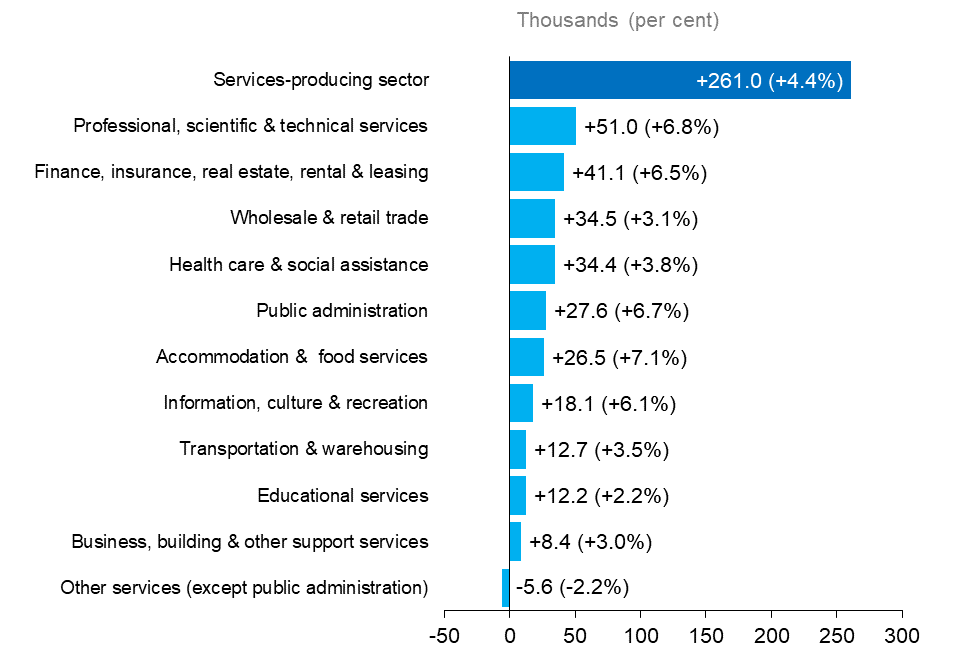
The horizontal bar chart shows Ontario’s annual employment change by industry for services-producing industries, measured in thousands of jobs with percentage changes in brackets. All except one of the services-producing industries experienced an increase in employment, with the largest increase in professional, scientific and technical services (+51,000, +6.8%), followed by finance, insurance, real estate, rental and leasing services (+41,100, +6.5%), wholesale and retail trade (+34,500, +3.1%), and health care and social assistance (+34,400, +3.8%). Other services (except public administration) experienced a decline in employment (-5,600, -2.2%). The overall employment in services-producing industries increased by 261,000 (+4.4%).
Most services-producing industries experienced employment growth in 2022. Professional, scientific and technical services industries (+6.8%) had the greatest net employment growth, followed by finance, insurance, real estate, rental and leasing (+6.5%) and wholesale and retail trade (+3.1%). Other services (except public administration) was the only services-producing industry that experienced a decline in employment (-2.2%).
Employment change by occupational group, 2022footnote 3
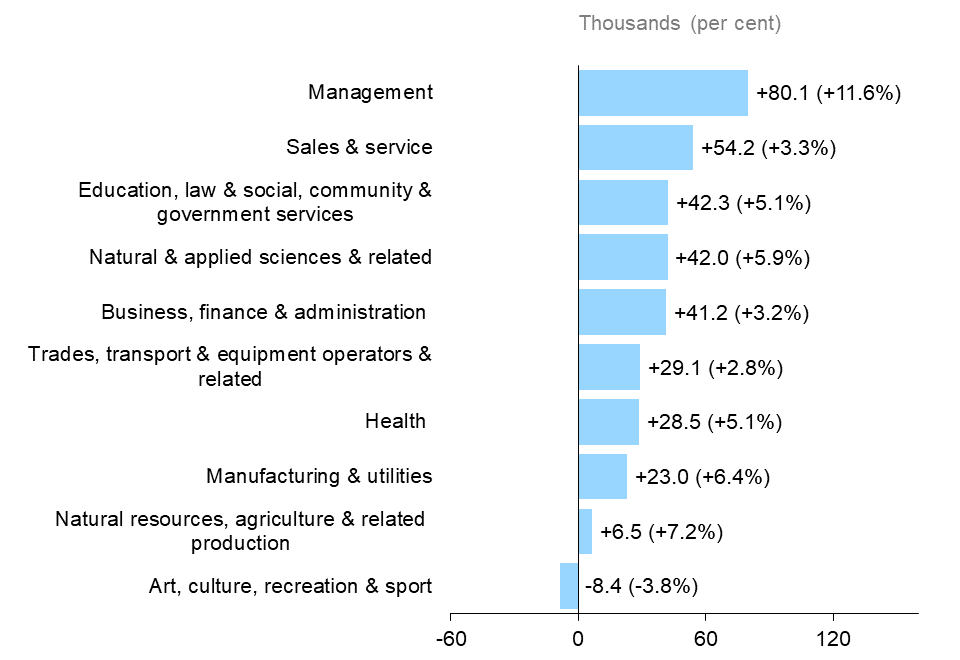
The horizontal bar chart shows Ontario’s annual employment change by broad occupational group, measured in thousands of jobs with percentage changes in brackets. Employment increased across all broad occupational groups, except occupations in art, culture, recreation and sport (-8,400, -3.8%). Management occupations experienced the largest employment increase (+80,100, +11.6%), followed by sales and service occupations (+54,200, +3.3%), occupations in education, law and social, community and government services (+42,300, +5.1%), natural and applied sciences and related occupations (+42,000, +5.9%), and business, finance and administration occupations (+41,200, +3.2%).
Among broad occupational groups, management occupations (+11.6%) saw the largest increase in employment followed by sales and service occupations (+3.3%) and occupations in education, law and social, community and government services (+5.1%). Occupations in art, culture, recreation and sport was the only broad occupational group to experience a decline in employment (-3.8%).
Regions
Ontario regions
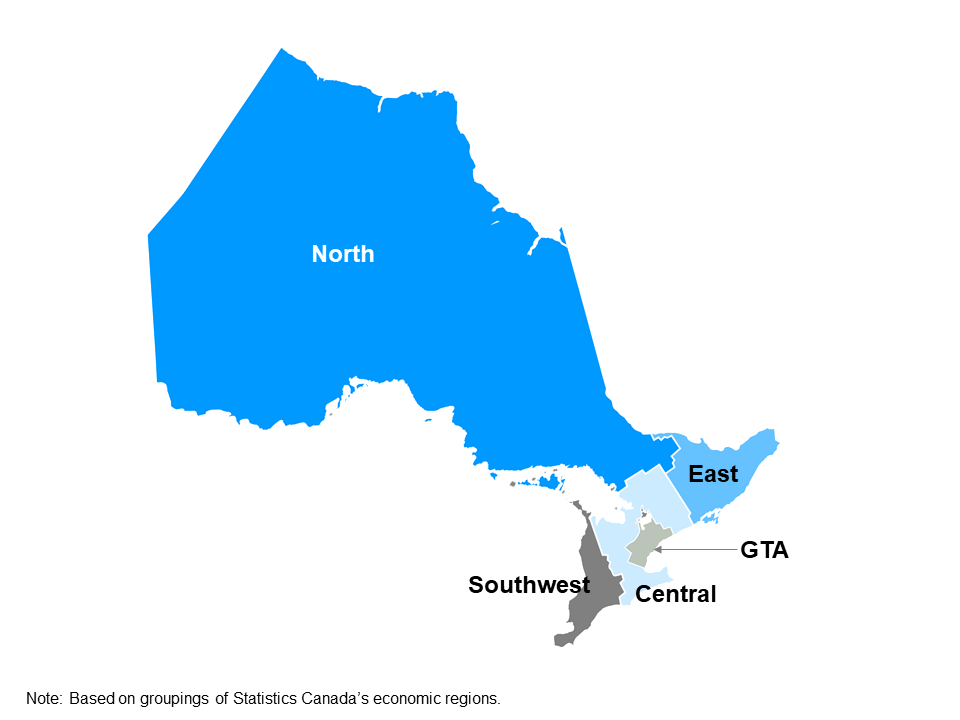
The map shows Ontario’s five regions: Northern Ontario, Eastern Ontario, Southwestern Ontario, Central Ontario and the Greater Toronto Area. This map is based on Ministry of Finance’s groupings of Statistics Canada’s economic regions.
Employment change by region, 2022
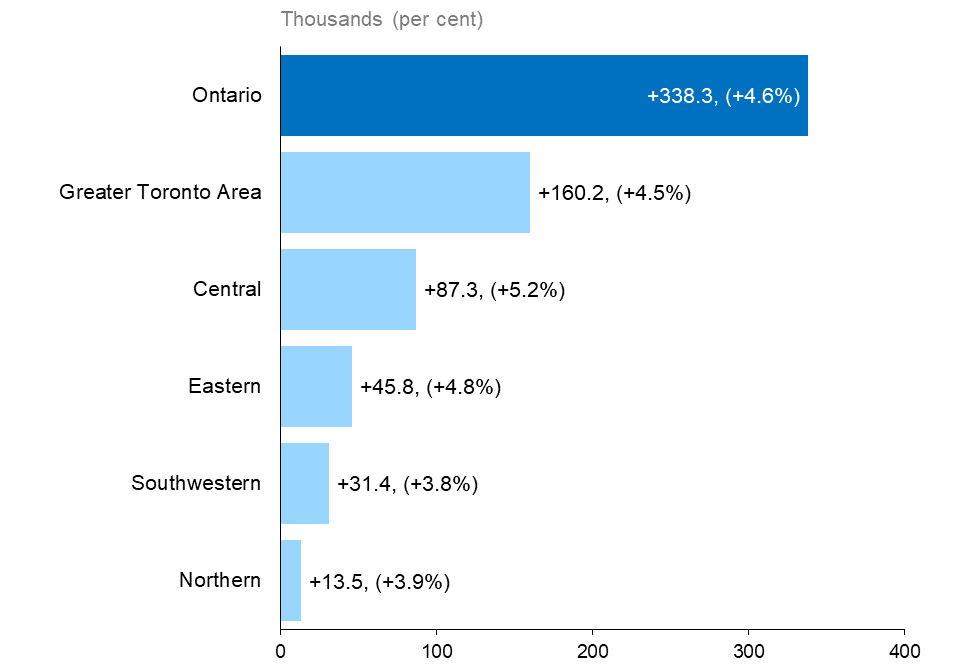
The horizontal bar chart shows Ontario’s annual employment change in the five Ontario regions (Northern Ontario, Eastern Ontario, Southwestern Ontario, Central Ontario and the Greater Toronto Area (GTA)), measured in thousands of jobs with percentage changes in brackets. Employment increased in all Ontario regions in 2022. Employment increased the most in the GTA (+160,200, +4.5%), followed by Central Ontario (+87,300, +5.2%), Eastern Ontario (+45,800, +4.8%), Southwestern Ontario (+31,400, +3.8%), and Northern Ontario (+13,500, +3.9%). The overall employment in Ontario increased by 338,300 (+4.6%).
In 2022, all Ontario regions experienced employment growth. The Greater Toronto Area (GTA) experienced the largest employment increase (+160,200); however, Central Ontario experienced the greatest percentage increase in employment (+5.2%), followed by Eastern Ontario (+4.8%) and the GTA (+4.5%).
Unemployment rate by region, 2022
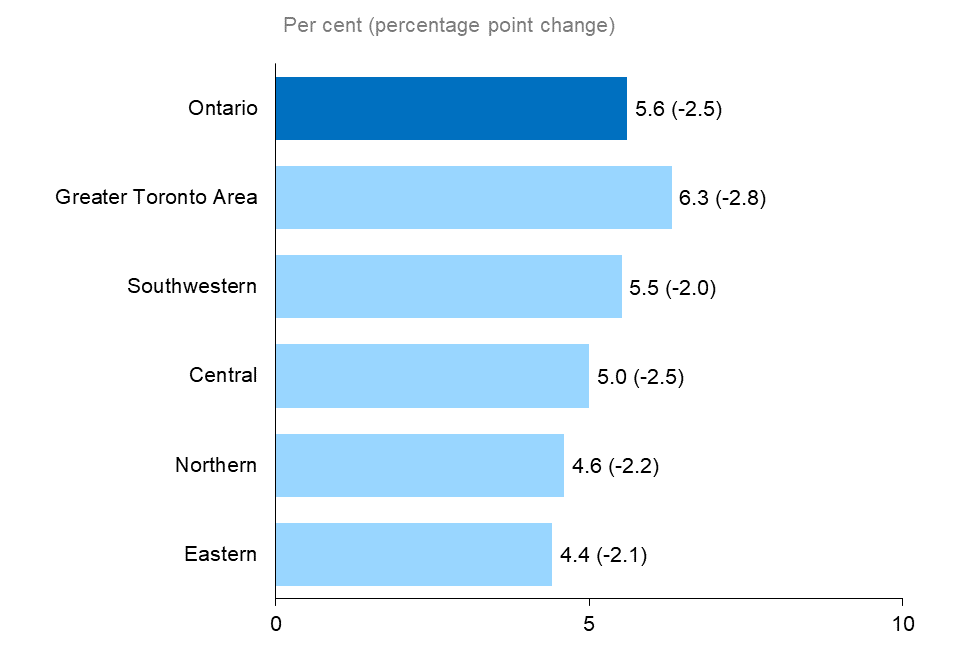
The horizontal bar chart shows unemployment rates by Ontario region in 2022, measured in per cent with annual percentage point changes in brackets. The Greater Toronto Area had the highest unemployment rate at 6.3% (-2.8 p.p.), followed by Southwestern Ontario (5.5%, -2.0 p.p.), Central Ontario (5.0%, -2.5), Northern Ontario (4.6%, -2.2 p.p.) and Eastern Ontario (4.4%, -2.1 p.p.). Ontario’s unemployment rate in 2022 was 5.6% (-2.5 p.p.).
In 2022, the unemployment rate decreased in every region. The GTA had the highest unemployment rate (6.3%) while Eastern Ontario had the lowest unemployment rate (4.4%).
Participation rate by region, 2022
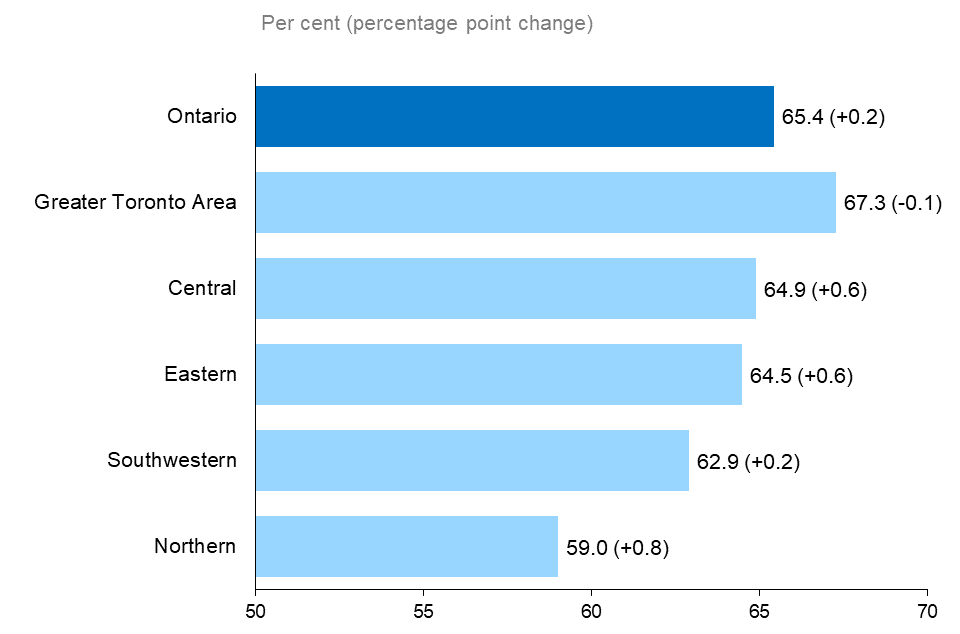
The horizontal bar chart shows participation rates by Ontario region in 2022, measured in per cent with annual percentage point changes in brackets. The Greater Toronto Area had the highest participation rate at 67.3% (-0.1 p.p.), followed by Central Ontario (64.9%, +0.6 p.p.), Eastern Ontario (64.5%, +0.6 p.p.), Southwestern Ontario (62.9%, +0.2 p.p.) and Northern Ontario (59.0%, +0.8 p.p.). The overall participation rate for Ontario was 65.4% (+0.2 p.p.).
In 2022, the participation rate increased in every region except in the GTA (-0.1 percentage point). The GTA had the highest participation rate (67.3%), while Northern Ontario had the lowest participation rate (59.0%).
Demographic groups
Employment change by age group and gender, 2022
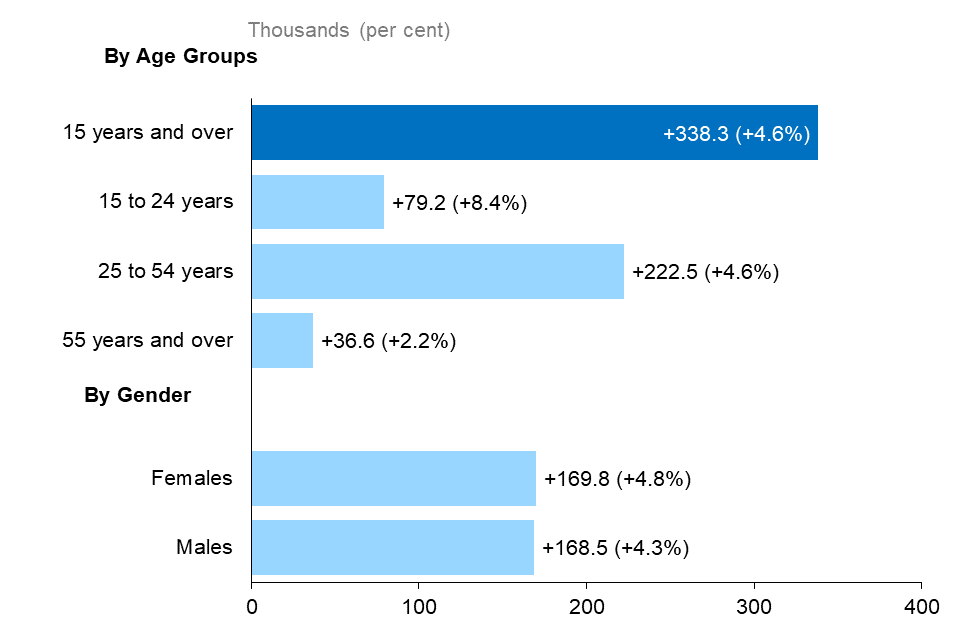
The horizontal bar chart shows Ontario’s annual employment change for three age groups, as well as by gender, compared to the overall population, measured in thousands of jobs with percentage changes in brackets. Employment increased among workers in all age groups. Ontarians aged 25 to 54 years had the greatest number of job gains (+222,500, +4.6%). Employment increased for Ontarians aged 15 to 24 years (79,200, +8.4%) and for Ontarians aged 55 years and over (+36,600, +2.2%). Total employment (for population aged 15 and over) increased by 338,300 (+4.6%). Male employment increased by 168,500 (+4.3%) and female employment increased by 169,800 (+4.8%).
In 2022, employment increased for all age groups and for both females and males. Females experienced slightly greater employment gains (+169,800, +4.8%) compared to males (+168,500, +4.3%). Employment levels increased the most for core-aged workers aged 25 to 54 years (+222,500, +4.6%), while youth aged 15 to 24 years registered the greatest percentage increase in employment (+8.4%).
Employment change by education level, 25 to 54 years, 2022
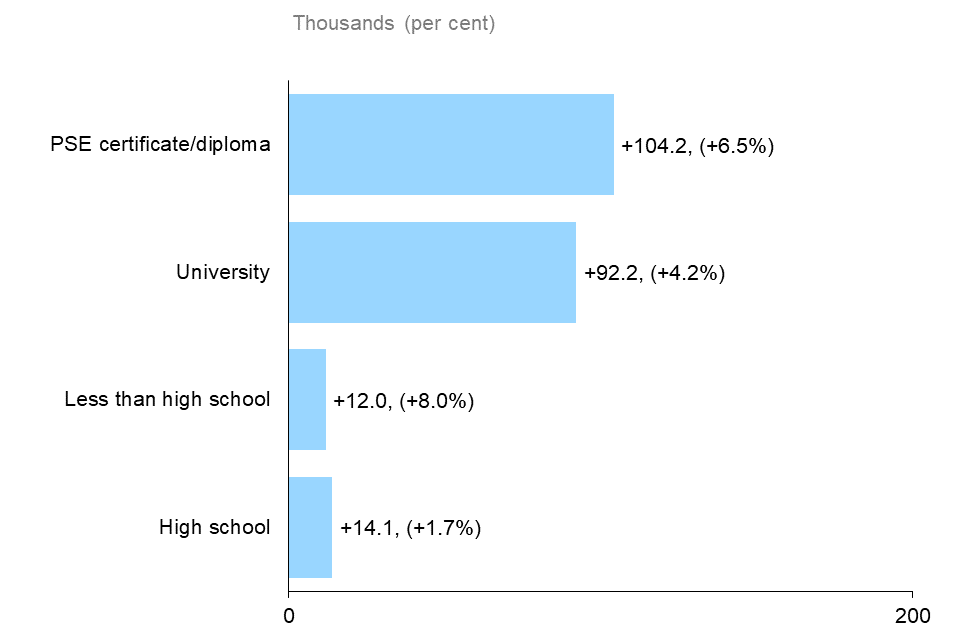
The horizontal bar chart shows Ontario’s annual employment change by education level for the core-aged population (25 to 54 years old) in 2022, measured in thousands of jobs with percentage changes in brackets. Employment increased among workers with all education levels. Those with a postsecondary certificate or diploma had the greatest number of job gains (+104,200, +6.5%), followed by those with a university degree (+92,200, +4.2%), high school graduates (+14,100, +1.7%) and those without a high school diploma (+12,000, +8.0%).
Among the core-aged population, employment increased among all education levels. Those with a postsecondary certificate or diploma experienced the greatest employment increase (+104,200, +6.5%), followed by university graduates (+92,200, +4.2%). Those with less than a high school credential experienced the greatest percentage increase in employment (+8.0%), offsetting some of the employment losses in 2020 and 2021, but their employment level was still below the 2019 level.
Employment change by immigrant status, 25 to 54 years, 2022
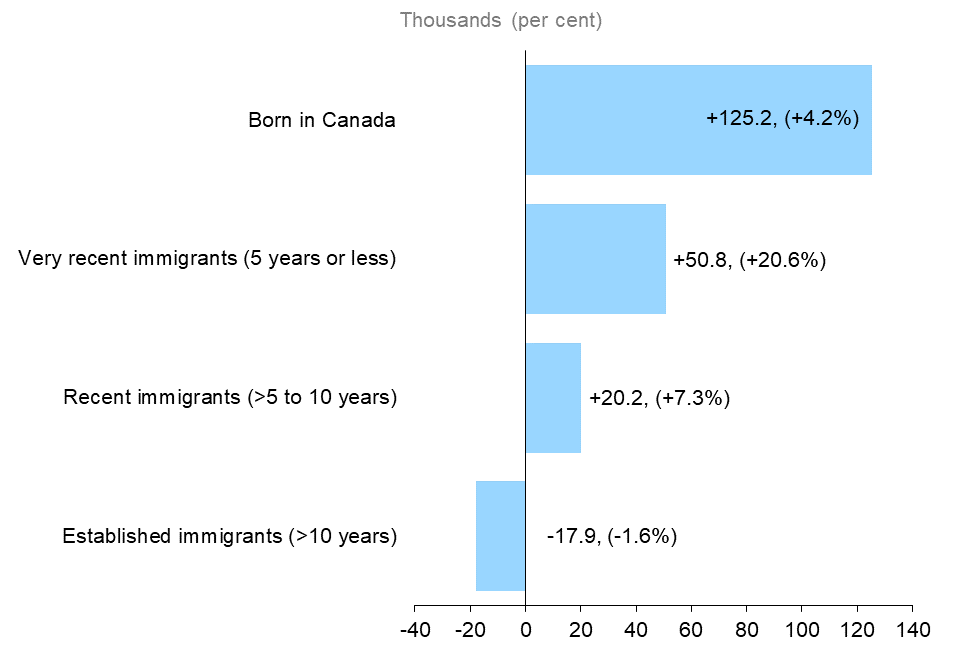
The horizontal bar chart shows Ontario’s annual employment change by immigrant status for the core-aged population (25 to 54 years old) in 2022, measured in thousands of jobs with percentage changes in brackets. All groups by immigrant status experienced employment gains, except for established immigrants who landed more than 10 years earlier (-17,900, -1.6%). Those born in Canada had the largest employment increase (+125,200, +4.2%), followed by very recent immigrants who landed 5 years or less earlier (+50,800, +20.6%) and recent immigrants who landed more than 5 to 10 years earlier (+20,200, +7.3%).
In 2022, those born in Canada and landed immigrants experienced an increase in employment, except for established immigrants (-1.6%). Very recent immigrants recorded the greatest percentage increase in employment (+20.6%), followed by recent immigrants (+7.3%), and those born in Canada (+4.2%). These employment changes were in part driven by the relative changes in the size of these groups. For instance, the population of core-aged very recent immigrants increased by 16.9%, while the population of the core-aged established immigrants shrank by 5.8%.
Wages
Real hourly wage change by type of work, 2022
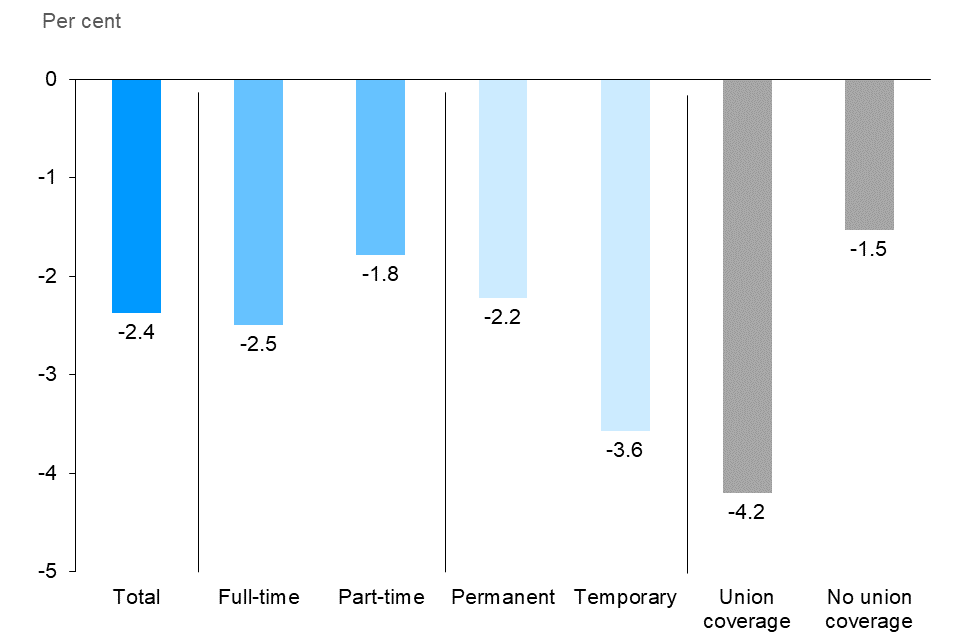
The vertical bar chart shows the annual change in Ontario’s real hourly wages by type of work in 2022, measured in per cent. The average hourly wage declined by 2.4%. Hourly wages decreased for both full-time (-2.5%) and part-time employees (-1.8%); permanent employees (-2.2%) and temporary employees (-3.6%); and employees with union coverage (-4.2%) and those without union coverage (-1.5%).
In 2022, the average hourly wage of Ontario employees was $32.94 per hour, an increase of 4.2% or a decrease of 2.4% in real terms
Real average wages declined for both full-time and part-time workers in 2022, due to a substantial increase in the Consumer Price Index (6.8%). In 2022, real hourly wages of permanent workers decreased by 2.2%, while those of temporary workers decreased by 3.6%. Real hourly wages of both unionized and non-unionized employees decreased by 4.2% and 1.5% respectively.
Average hourly wage by occupational group, 2022footnote 5
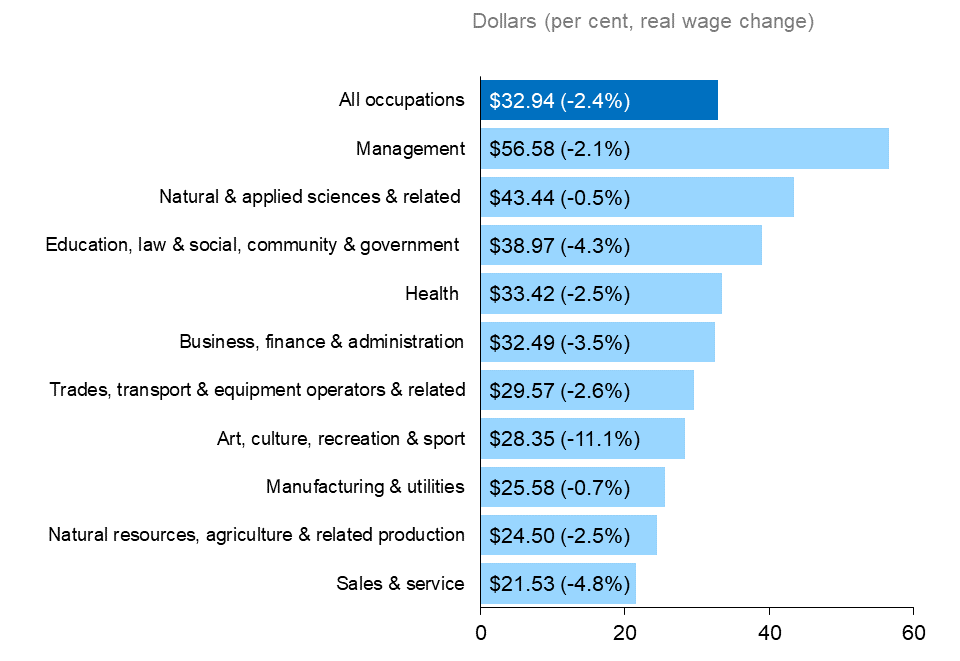
The horizontal bar chart shows average hourly wage rates in 2022, measured in dollars with per cent growth in real wages in brackets, by occupational group. In 2022, the average hourly wage rate for Ontario was $32.94 (-2.4%). The highest average hourly wage rate was for management occupations at $56.58 (-2.1%), followed by natural and applied sciences and related occupations at $43.44 (-0.5%) and occupations in education, law and social, community and government services at $38.97 (-4.3%). The lowest average hourly wage rate was for sales and service occupations at $21.53 (-4.8%).
In 2022, employees in management occupations had the highest average hourly wage ($56.58), followed by natural and applied sciences and related occupations ($43.44) and occupations in education, law and social, community and government services ($38.97). Employees in sales and service occupations had the lowest average hourly wage ($21.53).
Employment change by real hourly wage, 2022footnote 6
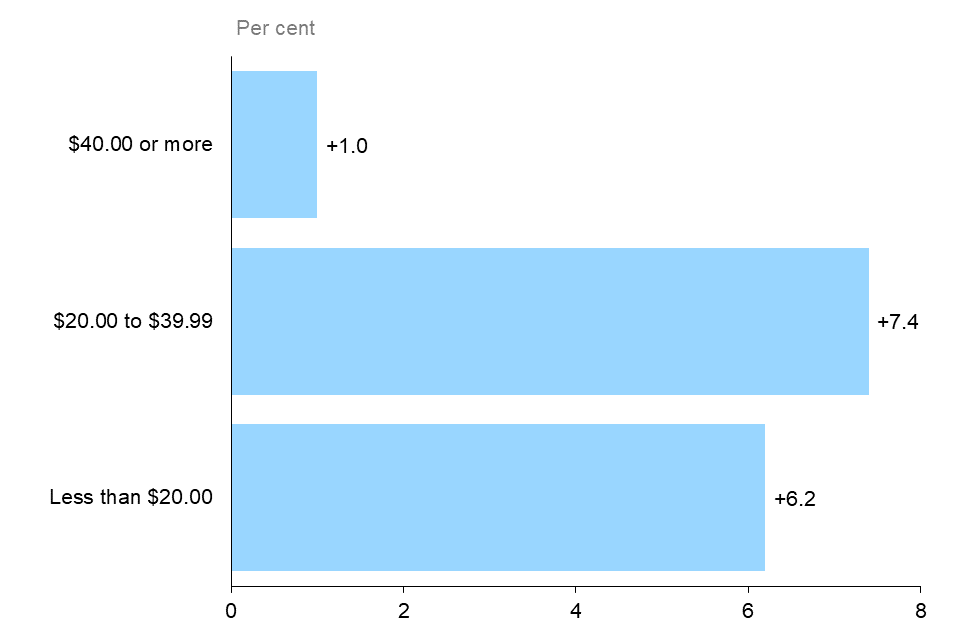
The horizontal bar chart shows Ontario’s annual employment change by real hourly wage in 2022, measured in per cent. Employment increased by 1.0% for those earning at least $40 per hour, by 7.4% for those earning hourly wages of $20.00 to $39.99 and by 6.2% among those earning less than $20 per hour.
In 2022, employment of workers earning less than $20.00 per hour in 2022 dollars increased by 6.2%, while employment of those earning between $20.00 and $39.99 per hour increased by 7.4% and employment of those earning $40.00 per hour or more increased by 1.0%.
Hours Worked
Total weekly hours worked, 1997-2022
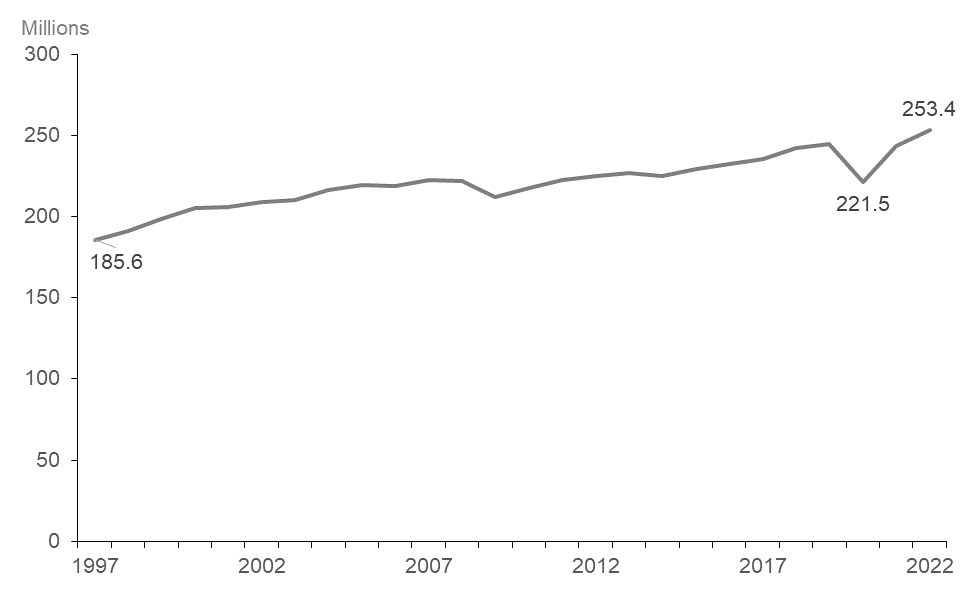
The line chart shows Ontario’s total weekly hours worked from 1997 through 2022, measured in millions of hours. Ontario’s total weekly hours have risen steadily since 1997 with a few exceptions when hours worked declined in 2008, 2009, 2014 and 2020. The decrease in total weekly hours worked from 2019 to 2020 was sharper compared to previous declines. However, total weekly hours increased from 185.6 million weekly hours in 1997 to 253.4 million hours in 2022, above the 2020 level of 221.5 million weekly hours.
In 2022, total weekly hours worked
Average actual hours worked by worker status, worked in reference week, all jobs, 2020, 2021 and 2022
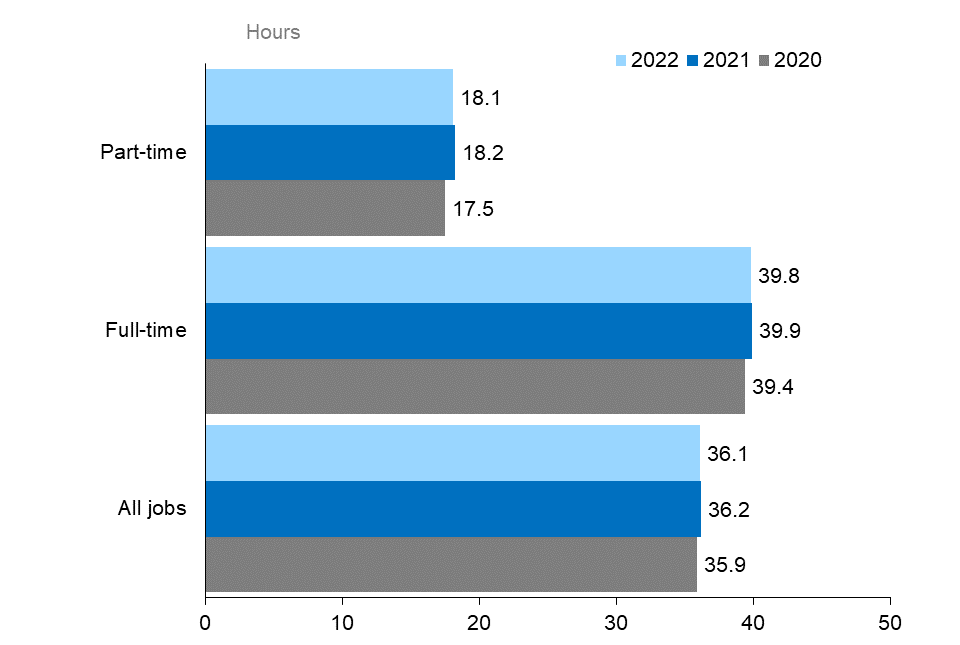
The horizontal bar chart shows the average actual hours worked in all jobs by worker status for those who worked in the reference week in 2020, 2021 and 2022. The average actual hours worked by part-time workers in all jobs were 17.5 hours in 2020, and 18.2 hours in 2021 and 18.1 in 2022. The average actual hours worked by full-time workers in all jobs were 39.4 hours in 2020, 39.9 hours in 2021 and 39.8 hours in 2022. The average actual hours worked by all workers who worked in the reference week were 35.9 hours in 2020, 36.2 hours in 2021 and 36.1 hours in 2022.
In 2022, part-time workers worked an average of 18.2 hours per week, almost matching the average hours worked in 2021 and were 0.6 hour higher compared to 2020. Those who worked full-time worked an average of 39.8 hours per work, essentially unchanged from 2021 and was 0.4 hours higher compared to 2020. The average total hours worked by all workers in all jobs remained essentially unchanged in 2022 at 36.1 hours per week.
Unemployment
Unemployment rate by province, 2022
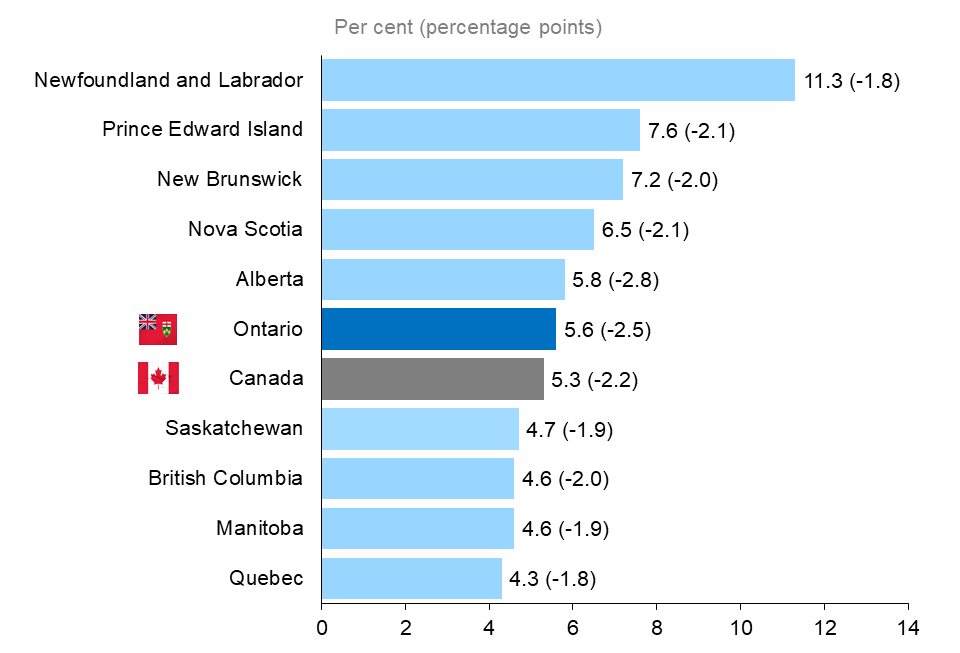
The horizontal bar chart shows unemployment rate by province in 2022, measured in percent with annual percentage point changes in brackets. Newfoundland and Labrador had the highest unemployment rate at 11.3% (-1.8 p.p.), followed by Prince Edward Island at 7.6% (-2.1 p.p.) and New Brunswick at 7.2% (-2.0 p.p.). Quebec had the lowest unemployment rate at 4.3% (-1.8 p.p.) and Ontario had the fifth lowest unemployment rate at 5.6% (-2.5 p.p.), above the national rate of 5.3% (-2.2 p.p.).
In 2022, all provinces experienced a decline in their unemployment rate. Ontario’s unemployment rate declined to 5.6%, 2.5 percentage points lower compared to 2021. Ontario had the fifth lowest unemployment rate among the ten provinces and was 0.3 percentage point above the Canadian rate of 5.3%. Quebec had the lowest unemployment rate (4.3%) and Newfoundland and Labrador had the highest (11.3%).
Unemployment rate by age group, 1997-2022
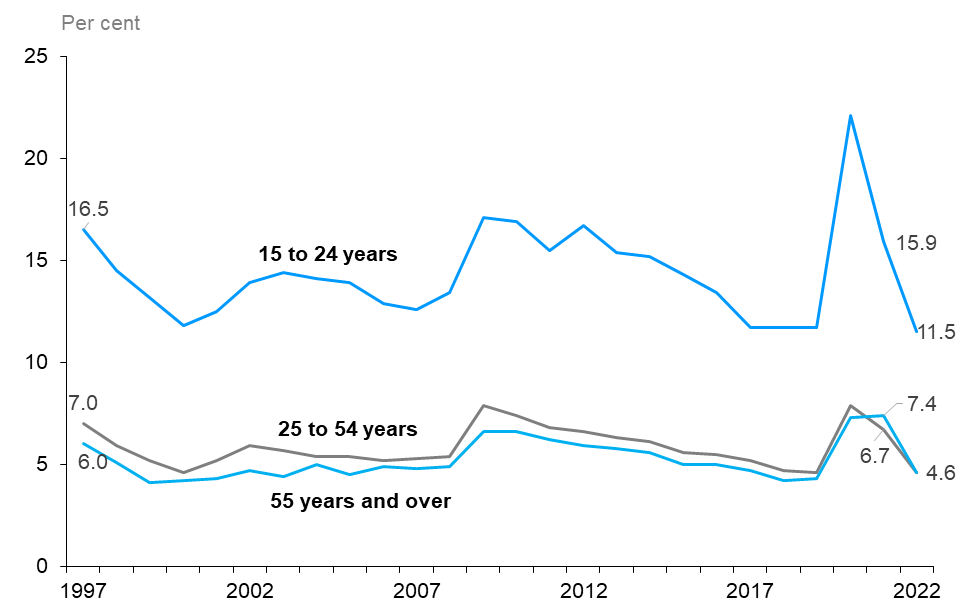
The line chart shows unemployment rates for three groups: youth (15 to 24 years), core-aged (25 to 54 years) and older population (55 years and older) from 1997 to 2022. The unemployment rate continued to decrease for youth (from 15.9% in 2021 to 11.5% in 2022) and core-aged population (from 6.7% in 2021 to 4.6% in 2022). The unemployment rate for older population also experienced a decrease compared to the previous year, reaching 4.6% in 2022. The unemployment rate of youth has historically been higher than those of the core-aged and older population.
In 2022, the unemployment rate decreased for youth aged 15 to 25 years (-4.4 percentage points), the core-aged population aged 25 to 54 years (-2.1 percentage points) and the older population aged 55 years and over (-2.8 percentage points). Youth had the highest unemployment rate (11.5%), followed by the older population and the core-aged population (both at 4.6%). The youth unemployment rate in 2022 reached its lowest rate since 1997.
Share of long-term unemployment, 1997-2022
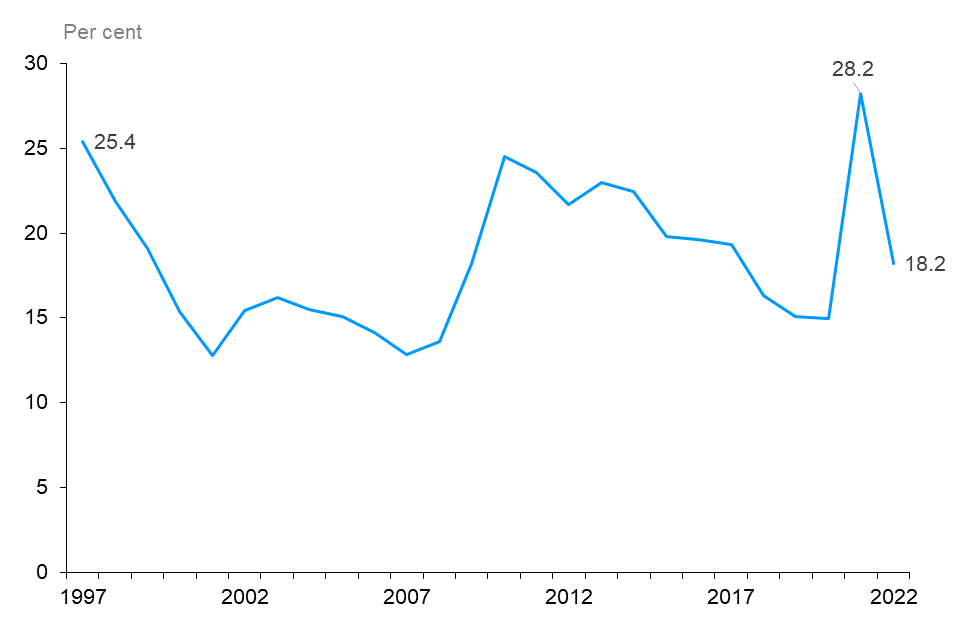
The line chart shows the share of those unemployed for long term as a share of total unemployment from 1997 to 2022, measured in per cent. The share has fluctuated in the past reaching lows of 12.8% in 2001, 12.9% in 2007 and 15.0% in 2020. The share rebounded and reached a high of 28.2% in 2021 before recovering to 18.2% in 2022.
In 2022, long-term unemployment (unemployed for 27 weeks or more) as a share of total unemployment declined from its highest point since 1997 of 28.2% in 2021 to 18.2% in 2022 (-10.0 percentage points).
The average duration of unemployment in 2022 was 19.7 weeks, 3.3 weeks lower than the average in 2021 (23.0 weeks).
Participation rates
Participation rate by province, 2022
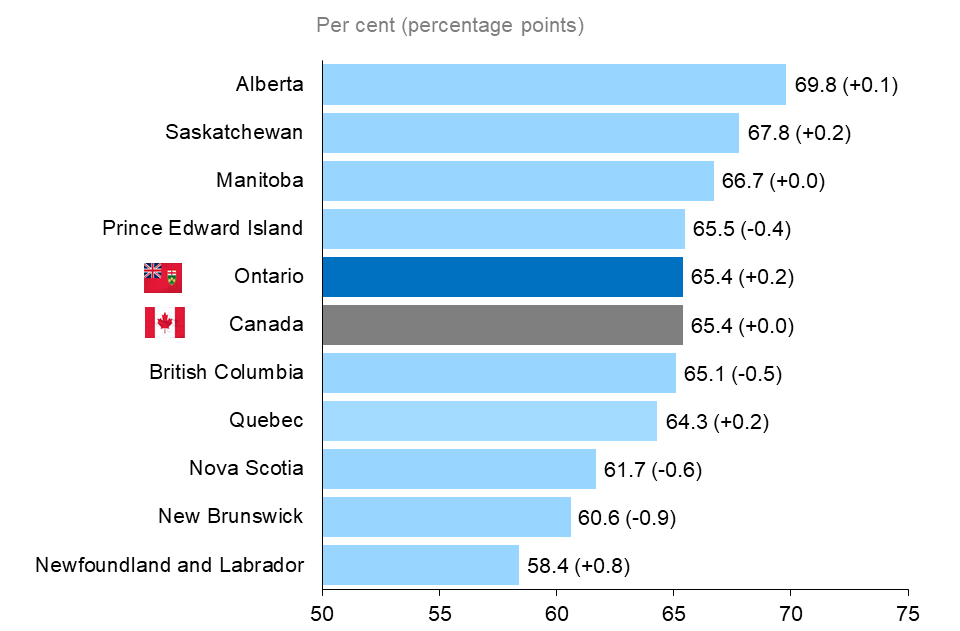
The horizontal bar chart shows the participation rate by province in 2022, measured in per cent with percentage point change from the previous year in brackets. Alberta had the highest participation rate at 69.8% (+0.1 p.p.), followed by Saskatchewan at 67.8% (+0.2 p.p.), and Manitoba at 66.7% (+0.0 p.p.). Newfoundland and Labrador had the lowest participation rate at 58.4% (+0.8 p.p.). Ontario had the fifth highest participation rate at 65.4% (+0.2 p.p.) and was the same level as the national rate of 65.4% (+0.0 p.p.).
In 2022, Ontario’s participation rate for people aged 15 years and over was 65.4%, which was unchanged compared to 2021. The participation rate in Ontario was the same as the Canadian average and is ranked fifth out of the ten provinces.
While Ontario’s participation rate has been on the decline since 2003, in part due to an aging population, recent increases has brought the rate back to the highest it has been since 2015. In 2022, there were 163,300 people who wanted work but were not part of the labour force, which is 25.0% less than in 2021.
Participation rate by gender, 2022
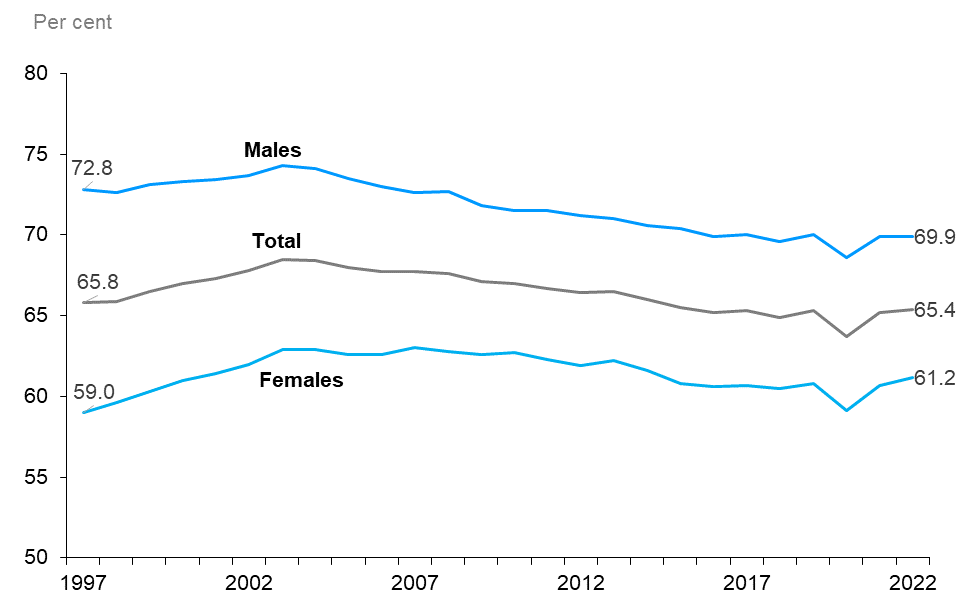
The line chart shows participation rates for the total population, males, and females from 1997 to 2022, measured in per cent. The participation rate of males has historically been higher than that of females. The participation rate of males has declined from 72.8% in 1997 to 69.9% in 2022 with some fluctuations in between, including a sharp decline in 2020. The participation rate of the total population declined from 65.8% in 1997 to 65.4% in 2022, including a sharp decline in 2020. The participation rate of females has been increasing since 1997 (59.0%) until the early 2000s, after which it declined reaching a low of 59.1% in 2020, followed by an uptick in 2022 to 61.2%.
In 2022, the participation rate of males stayed the same at 69.9%, following the recovery experienced in 2021 and remained 0.1 percentage point below its pre-pandemic rate in 2019. The participation rate of females increased by 0.5 percentage point in 2022 to 61.2%, 0.4 percentage point above its pre-pandemic rate of 2019.
Participation rate by age group, 1997-2022
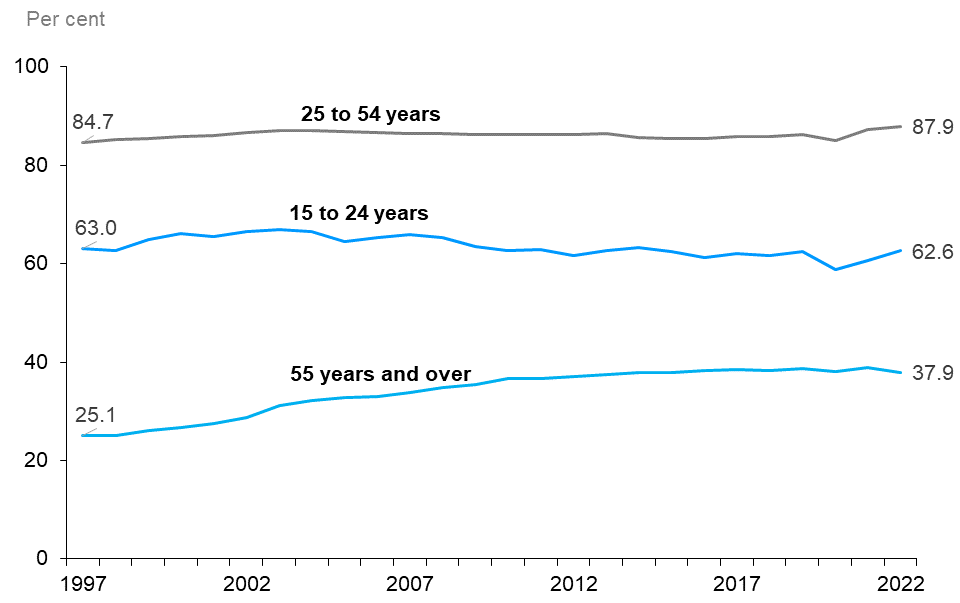
The line chart shows the participation rate for the three age groups: youth (15 to 24 years), core-aged people (25 to 54 years) and the older population (55 years and older) from 1997 to 2022, measured in per cent. In 1997, the core-aged population had the highest participation rate (84.7%), followed by youth (63.0%) and the older population (25.1%). Between 1997 and 2021, the rate declined for youth, increased for the older population and stayed relatively unchanged for the core-aged population. The participation rates increased for youth (from 60.7% to 62.6%) and core-aged groups (from 87.2% to 87.9%) between 2021 and 2022, but decreased slightly for the older population (from 38.9% to 37.9%).
In 2022, the participation rate of the core-aged population increased by 0.7 percentage point to 87.9%, the highest it has been since 1997. The participation rate of youth increased by 1.9 percentage points to 62.6% and was 0.1 percentage point above its pre-pandemic rate in 2019. However, the participation rate of the older population declined by 1.0 percentage point to 37.9% and was 0.8 percentage point below its pre-pandemic rate in 2019.
Appendix
10-year overview of annual employment
| 2013 | 2014 | 2015 | 2016 | 2017 | 2018 | 2019 | 2020 | 2021 | 2022 | |
|---|---|---|---|---|---|---|---|---|---|---|
| Total Labour Force (000) | 7,367.4 | 7,384.8 | 7,386.4 | 7,442.7 | 7,576.3 | 7,679.4 | 7,866.6 | 7,788.0 | 8,048.8 | 8,190.4 |
| Participation Rate (%) | 66.5 | 66.0 | 65.5 | 65.2 | 65.3 | 64.9 | 65.3 | 63.7 | 65.2 | 65.4 |
| Male Participation Rate (%) | 71.0 | 70.6 | 70.4 | 69.9 | 70.0 | 69.6 | 70.0 | 68.6 | 69.9 | 69.9 |
| Female Participation Rate (%) | 62.2 | 61.6 | 60.8 | 60.6 | 60.7 | 60.5 | 60.8 | 59.1 | 60.7 | 61.2 |
| Total Employment (000) | 6,806.9 | 6,840.0 | 6,887.0 | 6,956.4 | 7,117.3 | 7,245.9 | 7,429.2 | 7,025.9 | 7,393.3 | 7,731.6 |
| Full-time (000) | 5,463.4 | 5,497.5 | 5,580.0 | 5,630.5 | 5,740.5 | 5,883.4 | 6,042.3 | 5,801.0 | 6,088.9 | 6,372.4 |
| Part-time (000) | 1,343.5 | 1,342.6 | 1,307.0 | 1,325.9 | 1,376.8 | 1,362.5 | 1,386.9 | 1,224.9 | 1,304.4 | 1,359.2 |
| Employment-Population Ratio (%) | 61.4 | 61.1 | 61.1 | 60.9 | 61.3 | 61.3 | 61.6 | 57.5 | 59.9 | 61.8 |
| Male Employment (000) | 3,532.4 | 3,566.0 | 3,603.7 | 3,641.9 | 3,730.4 | 3,808.7 | 3,901.7 | 3,717.3 | 3,891.6 | 4,060.1 |
| Female Employment (000) | 3,274.5 | 3,274.0 | 3,283.3 | 3,314.5 | 3,386.9 | 3,437.2 | 3,527.5 | 3,308.5 | 3,501.7 | 3,671.5 |
| Part-Time (% of total) | 19.7 | 19.6 | 19.0 | 19.1 | 19.3 | 18.8 | 18.7 | 17.4 | 17.6 | 17.6 |
| Goods-Producing Sector Employment (000) | 1,410.4 | 1,393.8 | 1,406.7 | 1,440.2 | 1,457.5 | 1,476.8 | 1,474.6 | 1,415.5 | 1,466.2 | 1,543.5 |
| Services-Producing Sector Employment (000) | 5,396.5 | 5,446.2 | 5,480.3 | 5,516.2 | 5,659.8 | 5,769.1 | 5,954.6 | 5,610.4 | 5,927.1 | 6,188.1 |
| Private Sector Employment (000) | 4,488.2 | 4,542.1 | 4,545.4 | 4,613.4 | 4,741.5 | 4,809.6 | 4,936.5 | 4,600.1 | 4,876.4 | 5,127.2 |
| Public Sector Employment (000) | 1,278.2 | 1,259.5 | 1,276.2 | 1,280.5 | 1,299.0 | 1,319.2 | 1,343.5 | 1,327.9 | 1,429.1 | 1,515.7 |
| Self-Employment (%of total) | 15.3 | 15.2 | 15.5 | 15.3 | 15.1 | 15.4 | 15.5 | 15.6 | 14.7 | 14.1 |
| Total Unemployment (000) | 560.5 | 544.8 | 499.5 | 486.4 | 459.0 | 433.5 | 437.5 | 762.1 | 655.5 | 458.8 |
| Unemployment Rate (%) | 7.6 | 7.4 | 6.8 | 6.5 | 6.1 | 5.6 | 5.6 | 9.8 | 8.1 | 5.6 |
| Male Unemployment Rate (%) | 8.0 | 7.6 | 7.1 | 6.8 | 6.3 | 5.6 | 5.7 | 9.6 | 8.1 | 5.5 |
| Female Unemployment Rate (%) | 7.2 | 7.1 | 6.4 | 6.2 | 5.8 | 5.7 | 5.4 | 10.0 | 8.2 | 5.7 |
| Long-Term (27 wks+) (% of total) | 23.0 | 22.5 | 19.8 | 19.7 | 19.3 | 16.3 | 15.1 | 15.0 | 28.2 | 18.2 |
| Average Unemployment in Weeks | 21.9 | 21.9 | 20.1 | 19.9 | 19.1 | 17.2 | 16.0 | 15.4 | 23.0 | 19.7 |
| Youth Unemployment Rate (%) | 15.4 | 15.2 | 14.3 | 13.4 | 11.7 | 11.7 | 11.7 | 22.1 | 15.9 | 11.5 |
| 25-54 y.o. Unemployment rate (%) | 6.3 | 6.1 | 5.6 | 5.5 | 5.2 | 4.7 | 4.6 | 7.9 | 6.7 | 4.6 |
| 55+ y.o. Unemployment rate (%) | 5.8 | 5.6 | 5.0 | 5.0 | 4.7 | 4.2 | 4.3 | 7.3 | 7.4 | 4.6 |
| Average Weekly Wage Rate ($) | 916.61 | 931.31 | 959.81 | 985.76 | 993.13 | 1,030.52 | 1,058.44 | 1,136.25 | 1,161.63 | 1,216.43 |
| Average Hourly Wage Rate ($) | 25.07 | 25.45 | 26.20 | 26.92 | 27.16 | 28.18 | 28.95 | 30.86 | 31.60 | 32.94 |
Employment by region (000)
| 2013 | 2014 | 2015 | 2016 | 2017 | 2018 | 2019 | 2020 | 2021 | 2022 | |
|---|---|---|---|---|---|---|---|---|---|---|
| Greater Toronto Area | 3,229.6 | 3,221.8 | 3,281.6 | 3,320.9 | 3,392.6 | 3,471.5 | 3,576.0 | 3,387.5 | 3,568.5 | 3,728.7 |
| Central | 1,552.6 | 1,583.5 | 1,594.9 | 1,598.6 | 1,670.4 | 1,676.2 | 1,708.6 | 1,615.1 | 1,692.6 | 1,779.9 |
| Southwest | 769.8 | 776.2 | 775.6 | 784.6 | 793.8 | 817.0 | 817.4 | 770.6 | 833.1 | 864.5 |
| East | 897.2 | 900.9 | 885.7 | 902.5 | 906.8 | 922.0 | 967.8 | 909.9 | 954.4 | 1,000.2 |
| North | 357.5 | 357.8 | 349.0 | 349.7 | 353.7 | 359.2 | 359.3 | 342.8 | 344.7 | 358.2 |
Unemployment rate by region (%)
| 2013 | 2014 | 2015 | 2016 | 2017 | 2018 | 2019 | 2020 | 2021 | 2022 | |
|---|---|---|---|---|---|---|---|---|---|---|
| Greater Toronto Area | 8.2 | 8.1 | 7.1 | 6.9 | 6.5 | 6.0 | 5.9 | 11.0 | 9.2 | 6.3 |
| Central | 6.9 | 6.3 | 5.8 | 5.9 | 5.3 | 5.3 | 5.2 | 9.1 | 7.5 | 5.0 |
| Southwest | 7.7 | 6.9 | 7.0 | 6.1 | 5.7 | 5.3 | 5.4 | 9.2 | 7.5 | 5.5 |
| East | 6.5 | 7.2 | 6.7 | 6.4 | 5.9 | 4.8 | 5.0 | 7.7 | 6.5 | 4.4 |
| North | 7.5 | 6.8 | 7.2 | 7.4 | 6.6 | 6.1 | 6.0 | 7.9 | 6.8 | 4.6 |
Total employment by CMA (000)
Greater Toronto Area
| 2013 | 2014 | 2015 | 2016 | 2017 | 2018 | 2019 | 2020 | 2021 | 2022 | |
|---|---|---|---|---|---|---|---|---|---|---|
| Toronto | 3,075.2 | 3,061.9 | 3,130.4 | 3,155.7 | 3,235.3 | 3,301.4 | 3,412.1 | 3,227.0 | 3,409.2 | 3,569.4 |
| Oshawa | 192.9 | 198.2 | 192.6 | 209.9 | 206.4 | 215.5 | 214.4 | 205.4 | 211.2 | 226.6 |
Central Ontario
| 2013 | 2014 | 2015 | 2016 | 2017 | 2018 | 2019 | 2020 | 2021 | 2022 | |
|---|---|---|---|---|---|---|---|---|---|---|
| Hamilton | 372.6 | 378.1 | 380.8 | 380.6 | 411.1 | 407.4 | 414.8 | 384.1 | 409.6 | 418.6 |
| Kitchener | 287.2 | 290.1 | 290.7 | 293.1 | 304.1 | 312.4 | 324.4 | 305.5 | 323.0 | 333.7 |
| St. Catharines-Niagara | 193.3 | 195.3 | 205.4 | 205.8 | 203.9 | 208.8 | 207.1 | 189.5 | 198.4 | 221.2 |
| Peterborough | 54.6 | 59.3 | 60.2 | 58.5 | 61.7 | 64.9 | 62.5 | 53.7 | 63.5 | 66.1 |
| Brantford | 68.8 | 68.8 | 70.0 | 70.4 | 72.7 | 70.5 | 78.7 | 72.0 | 74.2 | 77.7 |
| Guelph | 79.0 | 80.8 | 89.9 | 91.1 | 91.3 | 89.1 | 91.4 | 85.1 | 92.8 | 96.8 |
| Barrie | 108.2 | 109.7 | 106.3 | 102.7 | 114.5 | 112.4 | 117.6 | 118.7 | 115.5 | 124.3 |
Eastern Ontario
| 2013 | 2014 | 2015 | 2016 | 2017 | 2018 | 2019 | 2020 | 2021 | 2022 | |
|---|---|---|---|---|---|---|---|---|---|---|
| Ottawa | 527.6 | 532.6 | 530.1 | 545.5 | 551.5 | 564.1 | 589.8 | 557.8 | 590.2 | 610.5 |
| Kingston | 81.0 | 78.8 | 80.1 | 80.6 | 84.8 | 83.2 | 83.9 | 80.1 | 81.3 | 87.9 |
| Belleville | 40.7 | 35.2 | 32.3 | 33.4 | 41.1 | 41.9 | 51.8 | 49.6 | 50.0 | 57.4 |
Southwestern Ontario
| 2013 | 2014 | 2015 | 2016 | 2017 | 2018 | 2019 | 2020 | 2021 | 2022 | |
|---|---|---|---|---|---|---|---|---|---|---|
| London | 238.3 | 239.6 | 249.0 | 245.2 | 247.4 | 257.3 | 256.1 | 257.9 | 281.8 | 295.4 |
| Windsor | 155.4 | 155.9 | 157.6 | 164.0 | 163.4 | 166.5 | 171.6 | 152.1 | 168.3 | 174.7 |
Northern Ontario
| 2013 | 2014 | 2015 | 2016 | 2017 | 2018 | 2019 | 2020 | 2021 | 2022 | |
|---|---|---|---|---|---|---|---|---|---|---|
| Sudbury | 84.3 | 83.5 | 82.9 | 82.7 | 82.3 | 83.3 | 87.3 | 81.0 | 82.1 | 85.4 |
| Thunder Bay | 62.8 | 61.4 | 59.7 | 60.3 | 62.1 | 64.4 | 63.2 | 59.1 | 61.1 | 61.9 |
Note: All estimates in this appendix are based on Statistics Canada’s Labour Force Survey.
Footnotes
- footnote[1] Back to paragraph Since 1976, as this is the earliest year of the Labour Force Survey data available on statcan.gc.ca.
- footnote[2] Back to paragraph Public sector includes the federal, provincial, territorial and local general governments, health and social service institutions, universities, colleges, vocational and trade institutions, school boards, and government business enterprises.
- footnote[3] Back to paragraph Occupation estimates are based on the 2021 National Occupational Classification. Management occupations are classified under the management occupational category and the remaining categories exclude management occupations.
- footnote[4] Back to paragraph Real wages are based on nominal wages deflated by the Ontario Consumer Price Index (CPI) for all items. Self-employment is excluded.
- footnote[5] Back to paragraph Occupation estimates are based on the 2021 National Occupational Classification. Management occupations are classified under the management occupational category and the remaining categories exclude management occupations.
- footnote[6] Back to paragraph This chart is based on microdata, which has not been revised to incorporate the most recent revisions to the LFS as of the date of writing this report. Estimates in this chart may differ slightly from published estimates.
- footnote[7] Back to paragraph Comparisons are based on real 2022 dollars.
- footnote[8] Back to paragraph This is a 12-month average of the total number of hours actually worked by all employed persons in all jobs in the Labour Force Survey reference weeks.
- footnote[9] Back to paragraph This analysis includes only those workers that were at work during the Labour Force Survey reference week. When all employed persons are included, the average actual hours across all jobs also remained relatively unchanged from 2021.